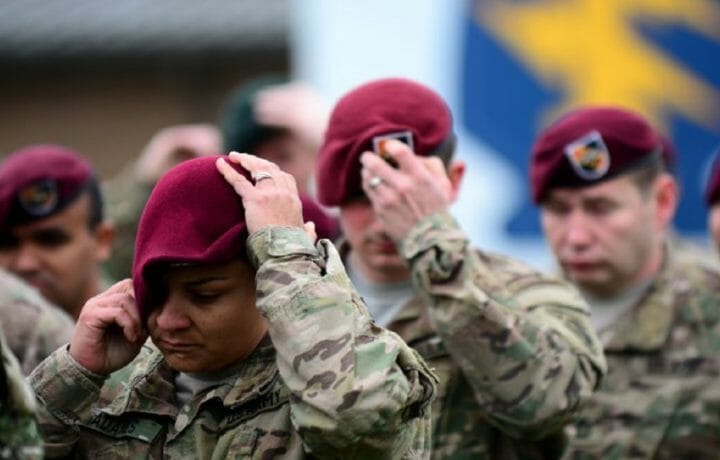New revelations in the case of the 2017 Niger ambush of Special Forces soldiers have exposed a potential weakness in the sustainability of the Security Force Assistance Brigades, the Army’s showcase adviser units.
In late 2017, Army Lt. Col. David Painter was a Special Forces battalion commander deployed to the African nation of Chad. It was his soldiers who died in neighboring Niger when their “key leader engagement” mission morphed into a mission to kill or capture Doundoun Cheffou, an African terrorist linked to the Islamic State. The counterterrorism mission-gone-wrong resulted in four dead soldiers and a slew of career-killing reprimands for the officers and senior non-commissioned officers responsible for planning, approving, and executing the mission (as well as the training prior to the mission).
Before he resigned suddenly in protest over U.S. military policy in Syria, Secretary of Defense James Mattis had ordered a review of many of those reprimands. After two investigations, Painter was one of the few officers to escape punishment. But last week, the Army confirmed that he will not be deploying to Afghanistan with the battalion of advisers he’s been training for the last year.
Politico military reporter Wesley Morgan uncovered the story, revealing that Painter has received a reprimand after all, albeit a “local” one that will not follow him throughout his career. As a result, he will not command his battalion—part of the 2nd Security Forces Assistance Brigade—when it deploys. Morgan’s sources told him Painter wasn’t relieved of his command, but that it was instead a “directed change of command” (a phrase with which I am not familiar despite a 25-year Army career).
While the Army’s treatment of Painter is a big story, it uncovers a larger issue that merits discussion: why are special operations officers filling the ranks of the SFABs?
Transformation of Foreign Internal Defense
Prior to the current conflict, the mission of teaching foreign forces how to fight an insurgency, the “Foreign Internal Defense” mission, belonged to Special Forces. But the Global War on Terror (if we can still call it that) has been a fight that has stretched the nation’s special operations forces farther than they were ever intended to stretch.
Beginning with the 2007 publication of the Counterinsurgency field manual (now called “Insurgencies and Countering Insurgencies”), the FID mission has been, in the words of retired Lt. Col. John Nagl, a “Big Army” mission. “While FID has been traditionally the primary responsibility of the special operating forces,” the manual read, “training foreign forces is now a core competency of regular and reserve units of all Services.”
The creation of the SFABs represented, as wrote when the 1st SFAB began its groundbreaking Afghanistan deployment a year ago, the ultimate triumph of Nagl’s idea to create a permanent advisor corps, separate from special operations, in the Army. The nation’s special operations forces, while the most competent in the world, cannot do it all. U.S. troop deployments have slowed significantly from their peaks amid the Iraq surge and later smaller surges into Afghanistan, but SOF continues to carry heavy load.
In his posture hearing testimony last year, Army Gen. Raymond Thomas, then commander of the multiservice U.S. Special Operations Command, revealed that the command has a goal for deployed-to-dwell time ratio of one-to-two, 12% of the force was below that. Even worse, three percent were blow one-to-one, meaning that they were literally deployed for longer than they were home.
SFABs ought to be relieving the strain on SOF
Those numbers are unsustainable in the long run. That kind of operational tempo, extended over time, will break the force. The creation of SFABs allows SOF to focus on unconventional warfare—training other irregular forces like the Kurdish peshmerga—and direct action against terrorist targets. So I find it curious that any special operations officers are working in the brigades at all.
Some have accused the SFABs of trying to become “SOF Lite” since their inception. Their origin patch design with its arrowhead and dagger topped by an “Adviser” tab, and their adoption of a unique beret (originally proposed to be an olive drab color) didn’t help that image. Knowing that at least one of the senior ranks are being filled by SOF officers whose unique skills are better applied elsewhere does not fill me with a great deal of confidence that SFABs will be successful in the long run.
Our combat roles worldwide are in their waning days. Security assistance is the “next big thing.” Sharing our expertise with allies and increasing their own military capacities supports strengthening alliances and partnerships, one of the three goals of the National Defense Strategy (and consequently one of the four goals of the Army Strategy). The SFAB model, which will eventually comprise five active brigades and one in the National Guard, is a central part of that effort.
But it must not come at the expense of SOF readiness.


